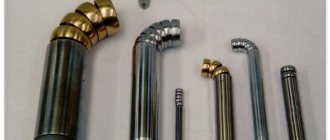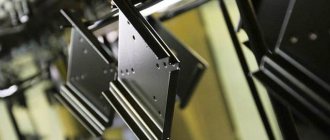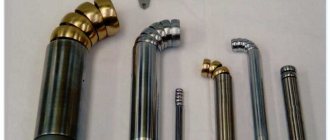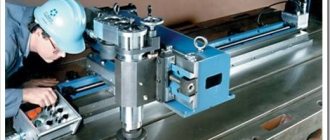Industrial processing of metals includes several dozen methods and techniques for changing the shape, volume and even the molecular structure of a material. Electrospark processing of metals is one of the most common technologies for working with metals, characterized by high accuracy and productivity. Using electric spark machines you can:
- cut metal;
- drill holes of microscopic diameter;
- increase defective areas of parts;
- produce jewelry work with precious metals;
- strengthen the surface of products;
- grind products of the most complex shapes;
- remove stuck broken drills and cutters.
Many industrial machines have been created based on the electric spark method of metal processing. This is high-precision and expensive equipment that only large enterprises specializing in metalworking can afford to buy.
Electric spark machine
But sometimes electric spark machines are also required in workshops or workshops where their services are required from time to time. To do this, you can buy an industrial device with somewhat limited capabilities (functionality within the most popular operations), or build a homemade electric spark machine. This is quite possible even at home, not to mention enterprises that include turning and electromechanical shops or areas.
Operating principle of an electric spark machine
The processing of metals by the electric spark method is based on the property of electric current to transfer a substance during breakdown. At high voltage and direct current (1-60 A), the anode (positively charged electrode) heats up to a high temperature in the range of 10-15 thousand degrees Celsius, melts, ionizes and rushes to the cathode. There, due to electrical interactions, it settles.
To prevent a full-fledged electric arc from occurring during operation, the electrodes are brought closer together only for short moments, lasting a fraction of a second. During this time, a spark occurs, destroying the anode and growing the cathode. The treated area is heated and exposed to electric current for milliseconds, while the neighboring areas and the underlying layer do not have time to warm up and their structure is not disturbed. The problem of borderline states does not arise in principle.
If cutting or drilling is required, the working tool serves as the cathode, and the workpiece serves as the anode. When building up, strengthening the surface or restoring the shape of a part, they change places. For these types of processing, special machines have been created, each of which performs its own operations.
The tools used in EDM installations are brass or copper-graphite electrodes, which conduct current well and are inexpensive to manufacture. With their help you can cut and drill the hardest alloys. To prevent the cathode metal from settling on the electrode and increasing its size, the process occurs in a liquid medium - the liquid cools the melt droplets, and it cannot settle on the electrode, even if it reaches it. The viscosity of the liquid determines the speed of movement of material particles, and they cannot keep up with the current. The metal settles in the bath as a sediment and does not interfere with the further passage of current.
When increasing the surface of parts or strengthening, metal is transferred from the anode to the cathode. In this case, a positive electrode is fixed to the vibration installation, serving as a metal donor, and the part is connected to the negative pole. No water or oil is used in this process, everything happens in the air.
Electric spark processing of material.
Electric spark machining involves using the phenomenon of electrolytic erosion and transferring the tool metal to the build-up surface of the part when spark discharges pass between them.
In electrical installations (switches, contactors, switches), sparks are formed at the moments of closing and opening the electrical circuit, which gradually destroy the surface of the contacts. This phenomenon is called electrical erosion. Particularly severe erosion is observed in DC circuits. This is explained by the fact that air ionization occurs between the energized electrodes, thereby creating a narrow channel that conducts current. An electron avalanche (in the form of a spark), breaking through the air gap, transfers a significant amount of electricity in a very short period of time from the cathode to the anode. In this case, a small part of the anode surface is heated to a very high temperature (10,000°C...15,000°C), which leads to melting and even evaporation of the metal, which is ejected from the spark gap in the form of liquid drops.
Let's consider electric spark processing (Fig. 1). The workpiece is the anode in the electrical circuit, and the tool is the cathode. To prevent metal droplets from growing on the tool and changing its shape, the processing process is carried out in a liquid medium (oil, kerosene) that does not conduct electric current. The tool is fixed in a slider that makes vertical movements up and down using a solenoid regulator. An electrical circuit consists of direct current sources, a resistance that regulates voltage and current, and a capacitor that prevents the spark from turning into an electric arc. When the electrode is lowered so much that a small gap is formed between it and the product, an electric spark jumps and erosion of the product occurs. The electrode is then raised slightly and the processing cycle, lasting a fraction of a second, is repeated.
Rice. 1. Scheme of electric spark processing (firmware) 1 - solenoid; 2 - current source; 3 - resistance; 4 - capacitor; 5 - detail; 6 — liquid medium (oil, kerosene); 7—tool; 8 - slider
Rice. 2. Installation diagram for electrospark metal growth 1—switch; 2 - transformer; 3— rectifier; 4— capacitor; 5—vibrator; 6 - workpiece
The electrode is made of soft brass or copper-graphite mass, which can easily be given any shape and size. This method can be used to process both soft and hard metals (hardened steels, hard alloys, etc.).
Technological indicators of electric spark processing of metals depend on the applied processing mode. Thus, when flashing in hard mode (voltage 150...200 V, short circuit current 10...60 A and capacitor capacity 400...600 μV), you can get clean surfaces of classes I and II, and a metal volume of 150...300 mm3/min; when flashing in soft mode (voltage 25...40 V, current 0.1...1 A and capacitor capacity up to 10 μF), it is possible to achieve surface cleanliness corresponding to classes VI and VII, however, metal removal in this case will be less than 20 mm3/min .
Electric spark machining of metals is used for piercing holes of various shapes and sizes, removing remnants of broken tools and fasteners from products, surface hardening and building up a metal layer with minor wear.
Electric spark growth (Fig. 69) allows you to apply coatings from any metals and alloys, regardless of their hardness. This, as well as the low temperature of the part during processing, creates favorable conditions for building up a layer of metal on worn, hardened surfaces. Electrospark build-up restores the journals of the axles of road wheels, seats for bearings on shafts, bearing cups, journals for bearings on axles and other similar surfaces of parts in fixed and transitional fits.
When the electrode (anode), fixed in the vibrator clamps, comes into contact with the surface of the part (cathode), a spark discharge is formed, which transfers the metal from the anode to the cathode. Metal transfer occurs in the air and, unlike installations for piercing work, does not require the use of working fluids and baths.
The wear resistance and fatigue strength of machine parts strengthened by the electric spark method largely depends on the modes used and the strengthening material.
For electrospark growth of metal on parts, UPR-ZM and EFI-25 installations are used.
Technological indicators
An electric spark installation, depending on the operating mode, can ensure the accuracy of the result within a wide range. If high performance is required with relatively low requirements for surface condition (class I and II), then currents of 10-60 A are used at voltages up to 220V. In this case, electric spark erosion can remove metal from the cutting or drilling zone in a volume of up to 300 mm3/min. With higher accuracy class values - VI and VII, productivity decreases to 20-30 mm3/min, but lower currents are required, no more than 1 A at voltages up to 40 V.
Such a wide range of adjustments shows that electric spark processing of metal can be used in various fields, both for the production of large series of parts and for one-time work, including jewelry.
A feature of the use of electric spark installations can be considered the ability to strengthen parts of various configurations. A thin layer of a stronger alloy or metal is applied to the surface of the workpiece without heating the base to a greater depth. This allows you to preserve the metal structure of the base product and significantly change the properties of its surface. In some cases, base viscosity and high surface hardness are required, or vice versa. Only an electric spark machine can solve this problem.
Electric spark machine diagram
Metal processing by the electric spark method is very common, so it is very difficult to consider all types of equipment and models of specific installations. They are all united by common structural elements:
- DC source;
- capacitor;
- vibrator;
- mode switch.
A design operating in an electric spark mode may differ in a number of characteristics that allow it to work with a particular material, but the general principles of constructing a working circuit are the same.
The battery of capacitors is coordinated with the mechanical movement of the electrode, the discharge occurs at the moment of maximum approach of the working surfaces. Relaxation pulse generators determine the maximum charge of the capacitor at the maximum amplitude of deviation from the approach point. After the spark discharge, the capacitor has time to charge fully.
DIY electric spark machine
One of the main parts of an electric spark installation, which you can implement with your own hands, of course, subject to all safety rules, is given below. It should be noted that this is only one of many designs that can be used in machine design.
Approximate diagram of a spark discharge generator
The work table of the machine must be equipped with an oxide removal system (continuous supply of oil or kerosene). They reduce the likelihood of depositing an oxide film on the surface of the part and, as a result, stopping sparking. For breakdown, reliable electrical contact is required. As a basic option, you can use a bath filled with liquid.
The electrode is a brass or copper wire of the required diameter, which is fixed in a clamp. The clamp, in turn, is a part of the vertical rod of the crank mechanism, which is driven by an electric motor. The frequency of reciprocating movement of the electrode is selected depending on the characteristics of the material being processed.
All conductive parts and cables must be properly and reliably insulated, and the installation itself must be grounded. You can see how homemade homemade installations work in the video:
It should be noted that homemade machines will never equal the capabilities of industrial ones, for example the ARTA series. They may be suitable for the production of handicrafts or use as one of the types of hobbies, but they are not “up to par” for working in a workshop or metalwork shop. Not to mention that the complexity of the electrical circuit and the need for precise coordination of kinematics and capacitor discharge make them very difficult to adjust.
Electrolytic extension method
Restoring parts using the electrolytic buildup method involves depositing metal from an aqueous solution onto the part. Electrolytic build-up is used to increase the wear resistance and corrosion resistance of a part, restore the dimensions of a part, repair of pipeline systems and ship fittings, and for decorative purposes.
When repairing parts, use:
- chrome plating;
- leaving;
- copper plating and other coatings.
Chrome plating is used both in the repair of mechanical parts and in the manufacture of new parts. Chrome coatings can be smooth or porous. Smooth hard chrome has valuable physical and mechanical properties. Porous chrome plating is used to increase the wear resistance of ship parts operating in conditions of insufficient lubrication.
Bulk carrier Kkaye E. Barker, Lake Michigan
The wear resistance of cast iron coated with smooth chromium increases by 4-7 times, and that of cast iron coated with porous chromium increases by 30-150 times. To eliminate porosity, which limits the use of chromium coatings for ship parts operating in a corrosive environment, a combined coating is used; a layer of chromium is applied to the applied layers of copper, cadmium or nickel, or sequentially copper and nickel.
The thickness of the deposited chromium layer ranges from 15-30 microns. Chrome plating restores parts that have little wear, since the thickness of the chrome coating is practically in the range of 0.05-0.3 mm per side. With a large coating thickness, the strength of the chrome layer decreases, and chrome plating becomes economically unprofitable. The chrome plating process consists of the following operations.
Restore the geometry of the part:
- groove;
- grinding;
- polishing
Electrolytes of various compositions are used for electrolytic polishing:
- a mixture of sulfuric, phosphoric and chromic acids;
- a mixture of sulfuric and citric acids;
- a mixture of various mineral acids and glycerin.
Degrease the part in electric baths with electrolyte (30-50 g of caustic soda per 1 liter of water). To speed up the degreasing process, it is recommended to add sodium silicate (liquid glass) in an amount of 0.5-1 g/l. The electrolytic degreasing process lasts 2-3 minutes. Wash the parts in hot water and running water.
In this case, the part is subjected to pickling in order to remove oxide films that may form during the preparation of the part for chrome plating. Picking involves lightly etching the surface of the part in a 2-3% solution of sulfuric acid. At a solution temperature of 18–20°C, the part is kept for 4–5 minutes to equalize its temperature with the temperature of the electrolyte.
Bulk carrier Edgar B. Speer, Lake Michigan
The most widespread is anodic pickling, which consists in the fact that a part placed in a bath to heat it to the bath temperature and being the anode is held for 30-50 s under a current density of 20-26 A/dm2. Decapitate immediately before chrome plating. Typically, the surfaces of parts that are not subject to chrome plating are coated with varnish.
Suggested reading: Types and organization of ship repairs
Chrome plating is carried out in iron baths with double walls, the space between which is filled with hot water to regulate the constant temperature of the electrolyte in the bath. Water is poured into the bath, heated to a temperature of 70°C, electrolyte components are introduced, and a direct current of 6-12 V is connected. To equalize the electrolyte concentration, the part mounted on the suspension is dipped into the solution 3-4 times and then suspended on the cathode rod .
The current density during chrome plating is 20-50 A/dm2, and the duration depends on the thickness of the coating, the composition of the electrolyte, and the operating mode of the bath. The anode for chrome plating is lead plates, located concentrically relative to the part and having a surface 2 times larger than the surface of the part being chromed.
After chrome plating, the part is subjected to anodic treatment in order to obtain a porous surface at a current density of 25–35 A/dm2 and at a temperature of 30–40°C for 10–20 minutes. Then the part is washed with cold and hot water.
Remaining is the process of electrolytic deposition of iron coatings from aqueous solutions of iron chloride FeCl24H2O or iron sulfate FeSO47H2O. Electrolytic deposition of iron from aqueous salt solutions was obtained by academicians B. S. Jacobi, E. I. Kleiman and E. X. Lenz in 1868-1870. When a direct current passes through a salt solution, iron ions are discharged at the cathode (part), thus covering the cathode with a layer of iron. The anode dissolves and its ions enter the solution.
On the. rice. Figure 3 shows a diagram of an installation for cooling parts, which consists of a bath with electrolyte 1, a ring anode 2, a suspension 3 for fastening the part to be coated, a thermometer 4 for monitoring the temperature of the electrolyte, a generator 5, an electric coil for heating the bath 6, and a rheostat 7.
Rice. 3 Installation diagram for remaining parts
Retaining is a less complex and cheaper process than chrome plating. For example, the current efficiency during cooling reaches 70–90%, the current density is 10–20 A/dm2, the deposit thickness per hour at the applied current density is 0.013–0.26 mm. The thickness of the iron layer with soft coating (140-225 HB) is more than 3 mm, with hard coating (225-600 HB) - up to 2 mm. Low-hardness coatings are used to restore non-friction surfaces of parts, the outer surfaces of bronze bushings of the connecting rod upper head, liners, etc.
The cooling technology is as follows:
- the part is cleaned of dirt;
- washed in gasoline;
- clean the areas covered with sandpaper or sandblasting;
- isolate areas not to be coated with perchlorovinyl varnish or rubber;
- mount the part on hangers;
- degreased with lime;
- washed with cold running water;
- passivated in a special electrolyte at a current density of 10-40 A/dm2 for 2-5 minutes;
- washed with hot water;
- load into a bath with electrolyte and heat the solution.
Taking the part out of the bath:
- washed with hot water;
- neutralized in an alkaline solution;
- washed with hot water;
- dismantle the suspensions;
- remove insulation;
- carry out aging;
- mechanically processed.
When cadmium ions are introduced into a chromium electrolyte, a coating is obtained that has:
- hardness;
- wear resistance;
- complete absence of porosity.
Bulk carrier American Integrity Source: www.shipspotting.com
Cadmium chrome coating is used, in particular, for propeller shaft journals and steel linings.
Copper plating is carried out to increase the protective and decorative properties of steel parts. In this case, multilayer coatings, copper-nickel or copper-nickel-chrome, are used. Copper is deposited on the nickel sublayer. In ship repair, sulfuric acid electrolytes are used for copper plating. Electrolytic copper is used as anodes.
Nickel plating of steel parts is carried out to increase their protective and decorative properties. Nickel protects the base metal from corrosion. Sometimes nickel coatings, due to their significant hardness, are used as wear-resistant coatings. When applying a nickel coating, the surface roughness of the part must be at least Rz = 80 ÷ 20 µm. For bright nickel plating, which does not require precise dimensions, the part is polished, and parts with precise dimensions are processed to Ra = 0.32 ÷ 0.16 µm.











